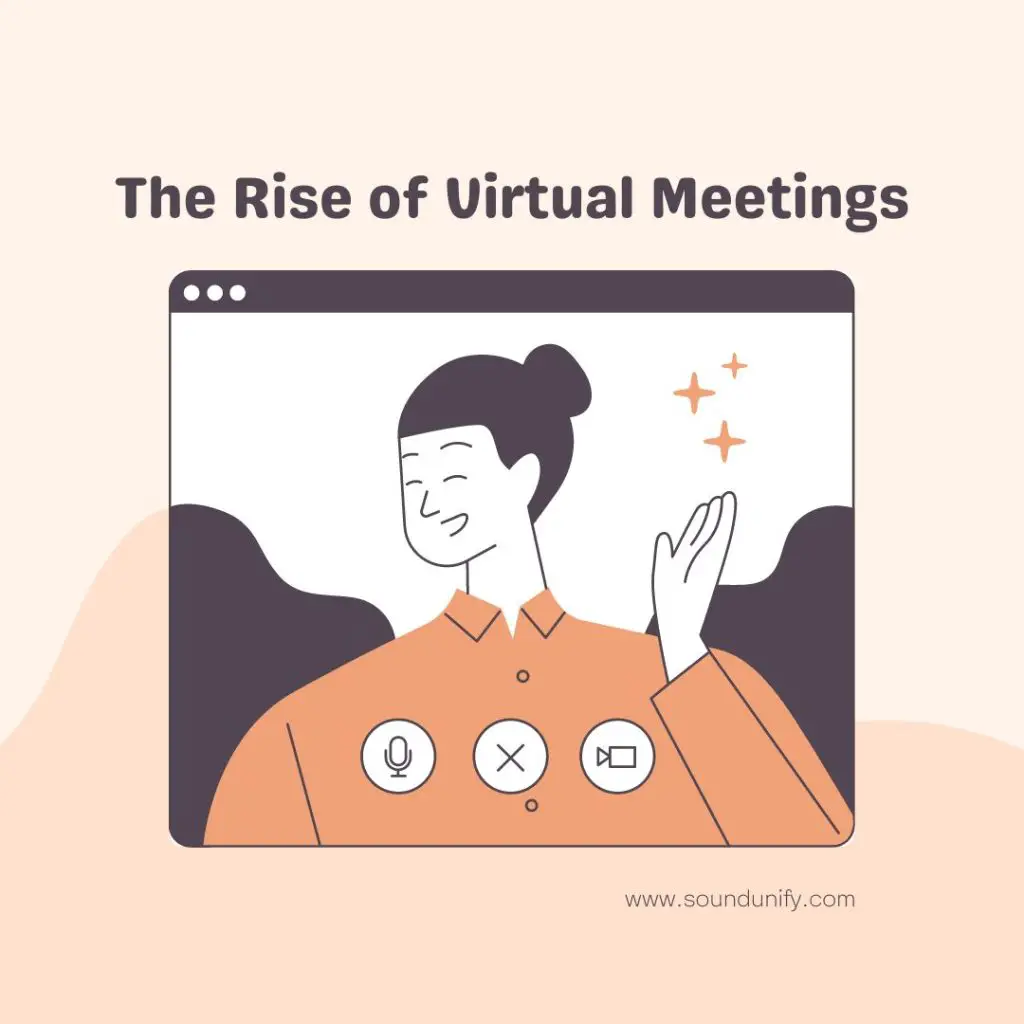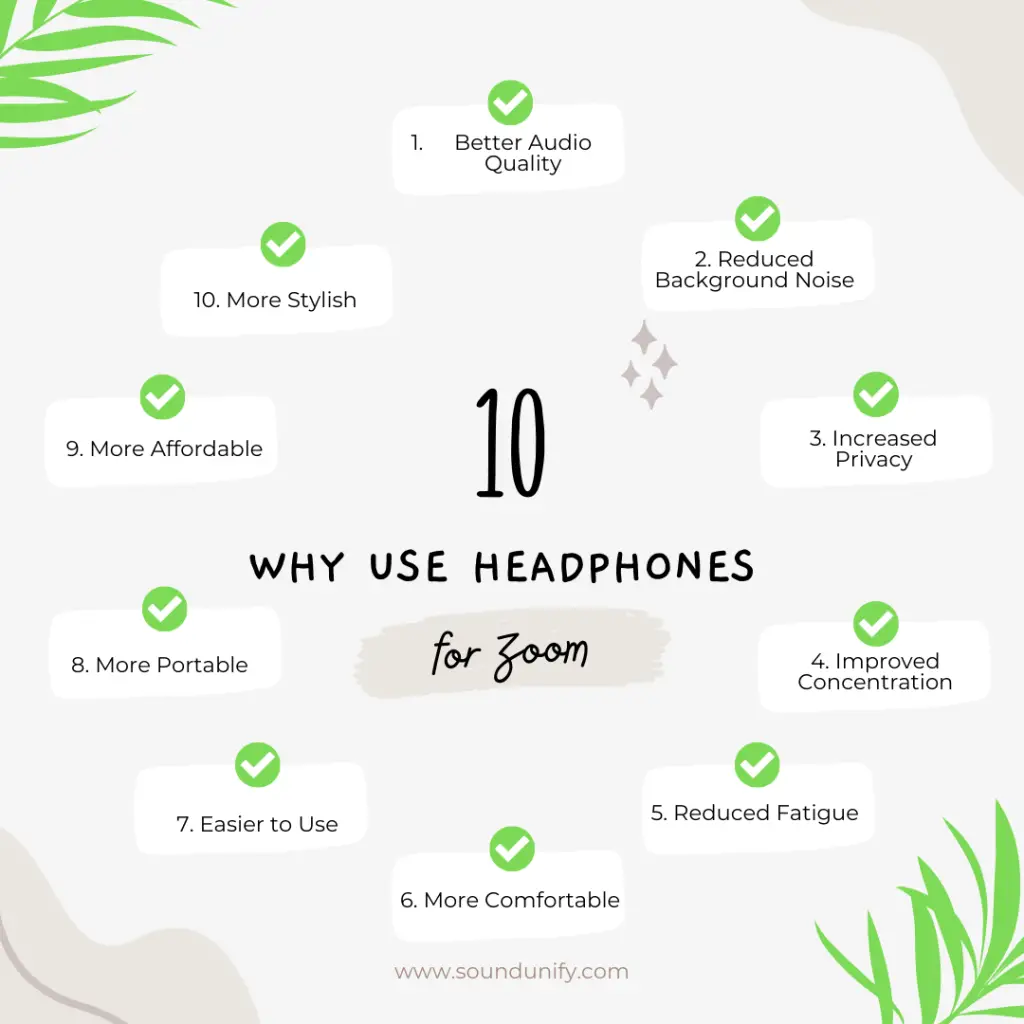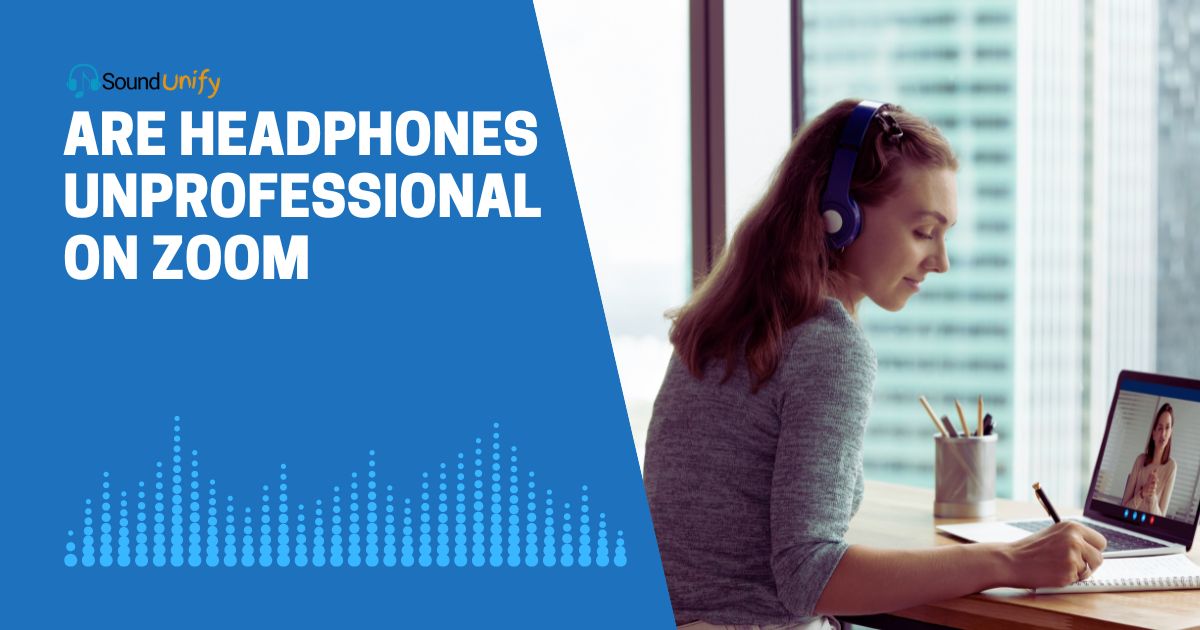No, headphones are not unprofessional on Zoom. In fact, they can enhance your virtual communication.
As I’ve been navigating the world of remote work, I’ve picked up on a recurring theme that seems to be causing some uncertainty. It revolves around the use of headphones during Zoom calls.
After all, we all want to present ourselves in the best light, especially in a professional setting.
But here’s the thing, headphones aren’t just about style or looking cool. They serve a practical purpose. Have you ever been in a Zoom meeting where you struggled to hear the speaker, or worse, your colleagues complained about your audio quality?
That’s where headphones come in. They can differ between a smooth, productive meeting and a frustrating one.
So, let’s dive deeper into headphones unprofessional on Zoom, shall we? Stick around as I share my thoughts and experiences using headphones during Zoom meetings.
The Rise of Virtual Meetings

In recent years, I’ve noticed a significant shift in how we conduct meetings. Gone are the days when we had to be physically present in a room to discuss ideas or make decisions.
Today, virtual meetings have become the norm, thanks to technological advancements and changing work dynamics.
1. The Impact of Technology
Firstly, let’s talk about technology. It’s been a game-changer. High-speed internet, powerful devices, and sophisticated software have enabled us to connect with anyone, anywhere, anytime.
Platforms like Zoom, Microsoft Teams, and Google Meet have made setting up and joining virtual meetings incredibly easy.
They offer features like screen sharing, real-time collaboration, and even virtual backgrounds that can make meetings more engaging.
2. The Shift to Remote Work
Secondly, the shift to remote work has played a significant role in the rise of virtual meetings. In the wake of the COVID-19 pandemic, many companies were forced to adopt remote work policies. This meant that meetings had to be conducted virtually.
Table: Growth of Remote Work (2005 to 2023)
| Year | Percentage of Remote Workers |
|---|---|
| 2005 | 3.6% |
| 2010 | 4.2% |
| 2015 | 4.9% |
| 2020 | 42% |
| 2021 | 57% |
| 2022 | 64% |
| 2023 | Estimated 70% |
Please note: The data for 2020 to 2023 is based on the trend observed in the growth of remote work due to the COVID-19 pandemic. And the increasing adoption of remote work models by companies. The exact percentage for 2023 is an estimate based on the current trend.
The data in the table represents the growth of remote work in the United States. The source, FlexJobs, primarily focuses on remote and flexible job trends in the U.S.
3. The Benefits of Virtual Meetings
Now, you might be wondering why virtual meetings have gained so much popularity. Well, I believe there are several reasons.
For one, they’re convenient. You can join a meeting from the comfort of your home or while on the go. This flexibility can lead to increased productivity and better work-life balance.
Secondly, virtual meetings can be more inclusive. They allow people from different geographical locations to participate, which can lead to more diverse ideas and perspectives.
Lastly, virtual meetings can be cost-effective. They eliminate the need for travel, saving time and money.
4. The Future of Virtual Meetings
Looking ahead, I believe virtual meetings are here to stay. They’ve proven to be an effective tool for communication and collaboration, and as technology continues to evolve, I expect they’ll only get better.
So, whether you’re a fan of virtual meetings, it’s worth getting comfortable with them. They’re a significant part of our digital future.
Why Use Headphones for Zoom?

As someone who frequently uses Zoom, I’ve found that headphones can significantly enhance the experience. Here are my top 10 reasons why you should consider using headphones for your next Zoom call:
1. Better Audio Quality
In my experience, headphones often provide superior audio quality compared to built-in speakers. They deliver clear, crisp sounds, making understanding what’s being said easier.
This can be particularly beneficial in a group meeting where multiple people speak.
- Clarity: I’ve found that headphones pick up subtle nuances in speech, ensuring every word is heard.
- Balance: They provide a balanced sound, clearly capturing high and low frequencies.
- Consistency: Headphones deliver consistent audio, reducing the chances of sound fluctuations during the meeting.
- Sound Isolation: Many headphones isolate the sound, meaning they deliver the audio directly into your ears without much loss, enhancing the overall listening experience.
2. Reduced Background Noise
In my experience, headphones can significantly reduce background noise, especially those with noise-canceling features. This allows you to focus on the meeting without being distracted by environmental noises.
- Noise Cancellation: Noise-cancelling headphones can filter out background noise, allowing you to hear the meeting more clearly.
- Focus: With less background noise, you can concentrate better on the discussion.
- Distraction-Free: Headphones can help create a distraction-free zone, especially in noisy environments.
3. Increased Privacy
When I use headphones, my conversation remains private. This can be crucial if you’re discussing sensitive information.
- Confidentiality: Headphones ensure that those around you don’t overhear your conversation.
- Professionalism: Maintaining privacy during meetings shows respect for the other participants and the topics being discussed.
4. Improved Concentration
By blocking out background noise, headphones can help you concentrate better. It’s as if you’re in your little bubble, allowing you to focus on the task.
- Isolation: Headphones can create a personal space, isolating you from external distractions.
- Productivity: You can be more productive during the meeting with improved concentration.
5. Reduced Fatigue
Listening to poor-quality audio can be tiring. With headphones, you won’t have to strain to hear what’s being said. This can reduce fatigue, especially during long meetings.
- Comfort: Many headphones are designed to reduce the strain on your ears during long meetings.
- Quality: High-quality sound from headphones can reduce the effort needed to listen, reducing fatigue.
6. More Comfortable
From my personal experience, many headphones are designed with comfort in mind. They come with padded ear cups and adjustable headbands.
This makes them more comfortable to wear for extended periods than in-built speakers.
- Ergonomics: Headphones are designed to fit comfortably over your ears, reducing strain during long meetings.
- Adjustability: Most headphones allow you to adjust the fit, ensuring they’re comfortable.
7. Easier to Use
Most headphones are plug-and-play. You connect them to your device, and you’re good to go. Many have built-in microphones so you won’t need additional equipment.
- Plug-and-Play: Headphones are easy to set up and use, making them a convenient choice for Zoom meetings.
- Built-in Microphone: Many headphones come with a built-in microphone, eliminating the need for additional equipment.
8. More Portable
Headphones are compact and easy to carry around. This makes them a great choice if you’re often on the move. You can easily take them with you and join a Zoom call from wherever you are.
- Compact: Headphones are small enough to fit in a bag, making them easy to carry around.
- Travel-Friendly: If you’re often on the move, headphones are a great way to ensure you can join a Zoom meeting from anywhere.
9. More Affordable
While there are high-end headphones that can be pretty pricey, there are also many affordable options that offer excellent sound quality. This makes headphones a cost-effective choice for improving your Zoom experience.
- Range of Options: Headphones are available at various prices, making it easy to find one within your budget.
- Cost-Effective: Considering their benefits, headphones can be a cost-effective investment for Zoom meetings.
10. More Stylish
Last but not least, headphones can be a stylish accessory. They come in various designs and colors, allowing you to express your style.
- Variety of Designs: Headphones come in various designs, from sleek and professional to colorful and funky.
- Personal Style: You can choose a pair of headphones that matches your style, adding a touch of personality to your Zoom meetings.
Table: 10 Reasons Why Use Headphones for Zoom
| No. | Reason | Details |
|---|---|---|
| 1 | Better audio quality | Headphones often provide superior audio quality, delivering clear and balanced sound. |
| 2 | Reduced background noise | Most headphones are plug-and-play. You connect them to your device, and you’re ready. |
| 3 | Increased privacy | Listening to poor-quality audio can be tiring. With headphones, you won’t have to strain to hear what’s being said. |
| 4 | Improved concentration | By blocking out background noise, headphones can help you concentrate better. |
| 5 | Reduced fatigue | With headphones, your conversation remains private, which can be crucial for discussing sensitive information. |
| 6 | More comfortable | Many headphones are designed with comfort in mind, making them more comfortable to wear for extended periods. |
| 7 | Easier to use | Headphones come in various designs and colors, allowing you to express your style. |
| 8 | More portable | Headphones are compact and easy to carry around, making them a great choice if you’re often on the move. |
| 9 | More affordable | While there are high-end headphones that can be quite pricey, there are also many affordable options that offer great sound quality. |
| 10 | More stylish | Headphones come in various designs and colors, allowing you to express your personal style. |
Is It Unprofessional to Wear Headphones on a Zoom Interview?
No, it is not unprofessional to wear headphones during a Zoom interview. However, the type and appearance of the headphones can influence the perception of professionalism.
In a Zoom interview, the primary focus is on clear communication. Headphones, especially those with a built-in microphone, can significantly improve audio transmission quality.
They can help reduce background noise and prevent echo, ensuring that you can hear the interviewer clearly and they can hear you.
However, it’s essential to consider the type of headphones you’re using. Large, over-the-ear headphones might be seen as too casual or distracting, while smaller, in-ear headphones or earbuds are often perceived as more professional.
Additionally, the context matters. If you’re interviewing for a tech company or startup role, wearing headphones might be acceptable or even expected.
However, a quiet room and a good-quality built-in microphone might be better in more traditional or formal industries.
Are Over-Ear Headphones Unprofessional?
No, over-ear headphones are not inherently unprofessional. However, their appropriateness can depend on the context and the specific environment.
Over-ear headphones are often associated with high-quality audio and noise cancellation. This makes them a practical choice for many professional settings, especially those that involve audio-focused tasks or work in noisy environments. They can help minimize distractions and improve focus, enhancing productivity and performance.
However, over-ear headphones might be perceived as too casual or bulky in certain situations, such as formal business meetings or video conferences. They can distract from your professional appearance, especially if they are brightly colored or flashy.
In more creative or tech-oriented fields, over-ear headphones are generally more accepted and can even be seen as a sign of a person’s dedication to high-quality audio or tech savviness.
Ultimately, the professionalism of over-ear headphones can depend on the specific workplace culture, the nature of the work, and the type of interaction.
It’s always a good idea to consider these factors and, when in doubt, opt for a more discreet option or check with your employer or colleagues.
Wearing Airpods During a Zoom Interview
Wearing AirPods during a Zoom interview is generally acceptable and advantageous. AirPods, or similar wireless earbuds, are compact and discreet, making them less likely to distract from your professional appearance than larger, over-ear headphones.
AirPods are known for their excellent sound quality, and the built-in microphone can provide clear audio, which is crucial during an interview.
They also have the added benefit of being wireless, which reduces the chances of dealing with tangled wires during your interview.
However, ensuring that your AirPods are fully charged before your interview is essential. You wouldn’t want them to run out of battery midway through your conversation.
Also, ensure you know how to use them and are correctly connected to your device before the interview starts.
How to Choose the Best Headphones for Meetings?
Choosing the right headphones for meetings can significantly enhance communication and overall experience. Here’s my guide to help you make an informed decision:
1. Understand Your Needs
Firstly, it’s essential to understand your specific needs. Are you often in noisy environments? Do you have back-to-back meetings and need comfortable headphones? Do you move around a lot during calls?
Answering these questions can help you identify the most essential features.
2. Key Features to Consider
- Sound Quality: Good sound quality is crucial for clear communication. Look for headphones that deliver crisp, balanced sound.
- Noise Cancellation: Consider headphones with noise-cancellation features if you’re in a noisy environment. They can help minimize background noise, allowing you to focus on your meeting.
- Microphone Quality: Your voice needs to be heard clearly during meetings. Some headphones come with built-in microphones that offer superior voice clarity.
- Comfort: If you have long meetings, comfort is vital. Look for headphones with padded ear cups and adjustable headbands.
- Battery Life: If you’re considering wireless headphones, consider battery life. You don’t want your headphones dying in the middle of a meeting.
3. Recommended Headphones
Based on these criteria, here are a few headphones I recommend:
- Sony WH-1000XM4: These offer excellent sound quality and noise cancellation. They’re also comfortable to wear for extended periods.
- Apple AirPods Pro: These are compact, have good sound quality, and offer active noise cancellation. They’re a good option if you prefer earbuds.
- Jabra Evolve 75: These are designed specifically for professionals. They offer excellent sound quality, superior noise-cancellation, and a good microphone.
Remember, your best headphones depend on your specific needs and preferences. Take the time to research, read reviews, and even try out different headphones if possible. This will ensure you find the perfect pair for your meetings.
FAQs
Q1: Should you wear headphones on Zoom?
A1: Yes, wearing headphones during a Zoom call can enhance the audio quality and reduce background noise, making it easier for you to hear others and for them to hear you. However, ensuring your headphones are professional-looking and do not distract from the conversation is essential.
Q2: Is it unprofessional to wear headphones in a meeting?
A2: No, wearing headphones in a meeting is not unprofessional. Headphones can improve communication by providing clearer audio. However, the type of headphones matters. Smaller, less noticeable headphones like earbuds are generally more acceptable in professional settings than larger, over-ear headphones.
Q3: Can you talk on Zoom with headphones?
A3: Yes, you can talk on Zoom with headphones, especially if they have a built-in microphone. This can often provide clearer audio than the built-in microphone on your computer or phone.
Q4: Do you need headphones for Zoom?
A4: While you don’t necessarily need headphones for Zoom, they can significantly improve the audio quality of your call. They can help you hear others more clearly and reduce the background noise your microphone picks up.
Q5: What are the best earphones for an interview?
A5: The best earphones for an interview provide clear audio, have a good-quality microphone, and are discreet. Some good options include the Apple AirPods Pro, Jabra Elite 85t, and Sony WF-1000XM4. However, the best choice depends on your specific needs and preferences.
Final Thoughts
Whether headphones are considered unprofessional on Zoom largely depends on the context and type of headphones used.
While larger, over-ear headphones might be considered too casual for formal meetings, smaller, less noticeable earbuds are often perceived as more professional.
The key is to ensure that the headphones enhance communication and do not distract from the conversation.
Ultimately, the focus should be on clear and effective communication, and if headphones can aid in that, they should not be deemed unprofessional. Always remember the right tool for the right job.
James Dimento is a Chief-in-Editor of SoundUnify. He is a headphone enthusiast and creative writer passionate about audio technology. He has three years of experience writing about headphones and sound quality and is responsible for creating reviews and taking care of all administration.
